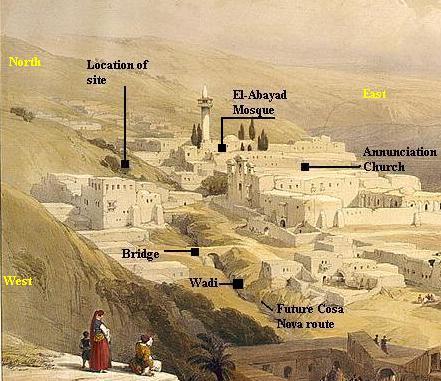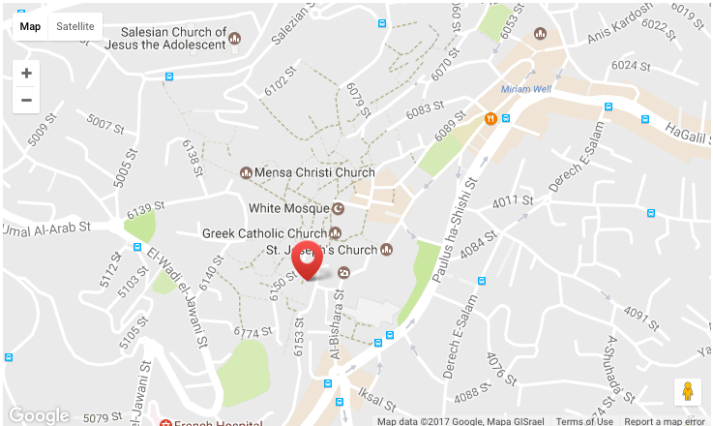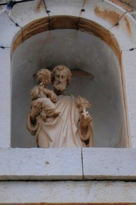Digging Up More of The Past in
Nazareth, Israel
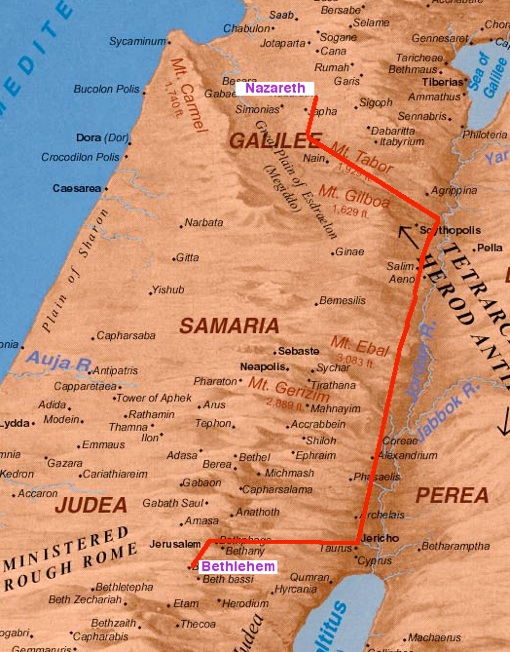
In 1881 a group of French nuns arrived in Nazareth and purchased stores and land. They then began constructing a convent, adjacent to the location of the Church of Annunciation.
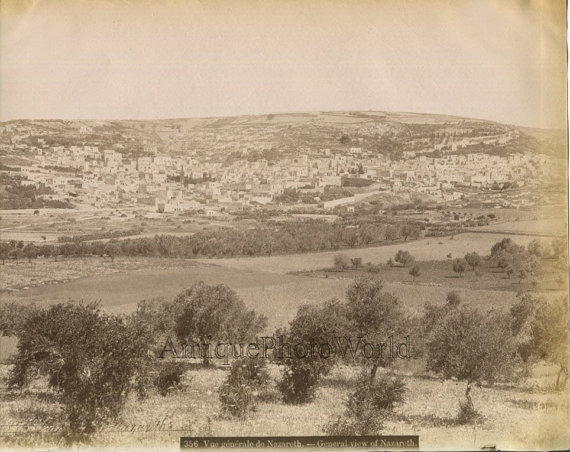 Old photograph of Nazareth
Old photograph of Nazareth
Archaeological evidence was discovered in 1884 at the site on which they were constructing their convent.
This chance discovery of an ancient cistern by the nuns meant an excavation was ordered and it was after that, the house they unearthed was first identified as being significant.
This included underground rooms, built walls and tombs, some of which date to the 1st Century AD.
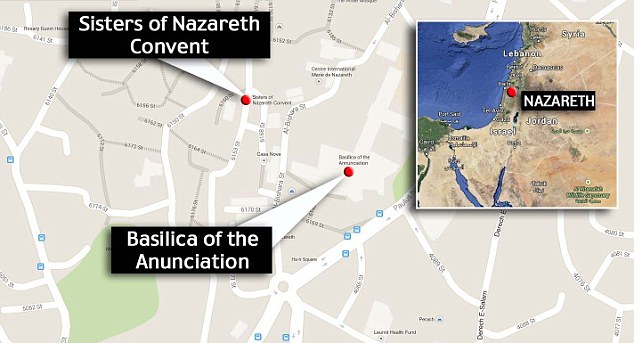
According to Dr Dark The house in question is located beneath the Sisters of Nazareth Convent, across the road from the Church of Annunciation.
The area of the excavations had been a Jewish burial site in the Roman period, but it also contained a dwelling in use prior to the construction of at least one of the tombs, itself dated to the 1st century.
The archaeological evidence at the convent remained almost entirely unpublished, and almost unknown to archaeologists,until 2006 when it was the subject of a 5-year study by the Nazareth Archaeological Project, directed by Dr. Ken Dark from the University of Reading in England.
Although no new excavation was conducted, modern archaeological recording of the existing remains and objects found, and re-analysis of the records made during nineteenth- and twentieth- century excavations, make it possible to date what was found at the convent much more accurately, and to interpret it in the light of what is known from other Roman and Byzantine sites.
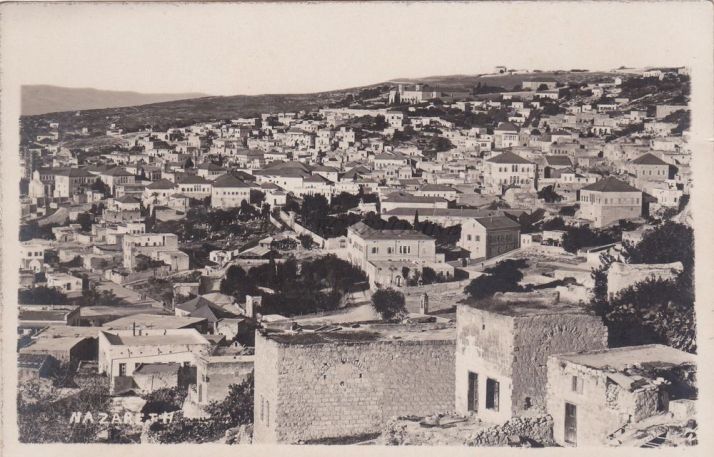
Dr. Ken Dark believes the first century dwelling mentioned above may be the humble home in Nazareth, northern Israel, as the place where Mary and Joseph lived and where Jesus grew up.
Example of a typical courtyard style house
Although The house was first discovered in the 1880s by nuns at the Sisters of Nazareth convent, it was not until 2006 that experts dated it to the first century.
In an article in Biblical Archaeological Review, Dr Dark, a professor at the University of Reading, said that there was “no good reason” why the courtyard style house was not the home of Jesus.
Library of Congress collection: Part of David Roberts’ illustration of Nazareth in 1839, which was painted before the construction of the convent.
Hewn into a hillside, this is the humble stone and mortar house (exterior pictured below). (It would seem archeologists may have made a major breakthrough in proving Jesus’ existence!)
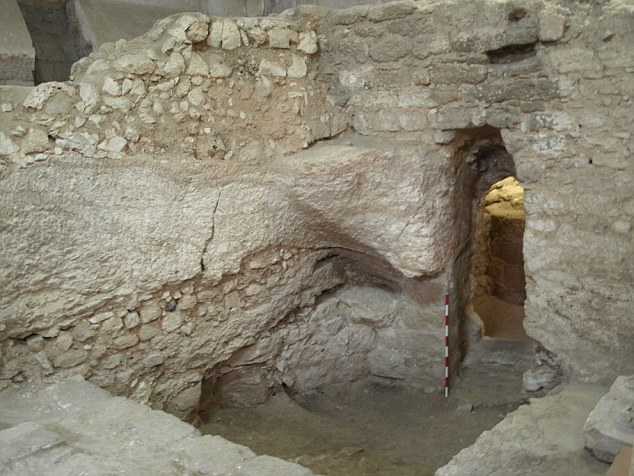
In the first century, two tombs were built beside what is believed to be Jesus’ home.
The forecourt of the tomb seen here passes through the abandoned home.
Dr Ken Dark describes it as having been cut out of a limestone hillside and having a series of rooms and a stairway
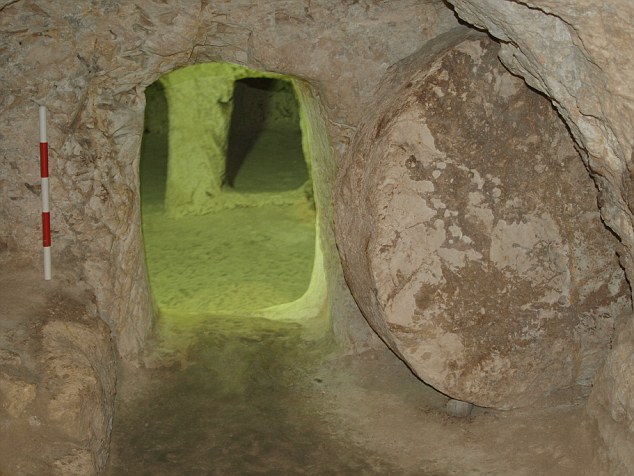
In the article Dr Dark wrote: “Great efforts had been made to encompass the remains of this building within the vaulted cellars of both the Byzantine and Crusader churches, so that it was thereafter protected.”
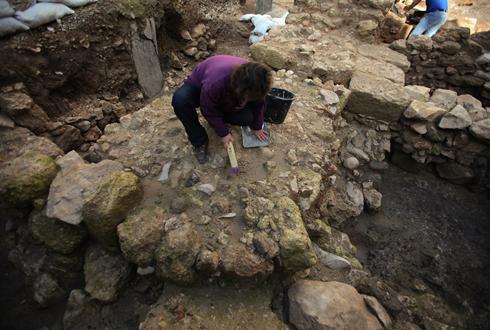
It then describes two churches in Nazareth, one of which was the Church of Annunciation, explained Dr Dark.
He writes: “The other stood nearby and was built near a vault that also contained a spring and the remains of two tombs.
“Between these two tombs was the house in which Jesus was raised.”
An ancient text points to the building as being the home in Nazareth where Mary and Joseph brought up the Son of God.
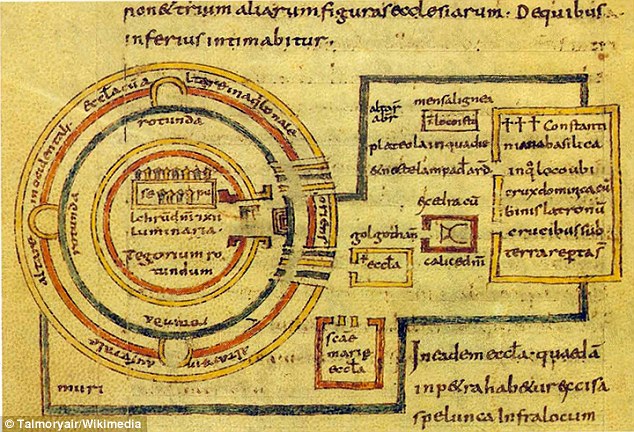
Professor Ken Dark says:
The key piece of archaeological evidence linking the site to Jesus, is a pilgrim text called ‘De Locus Sanctis’ written in 670 AD by abbot Adomnàn of the Scottish island monastery,
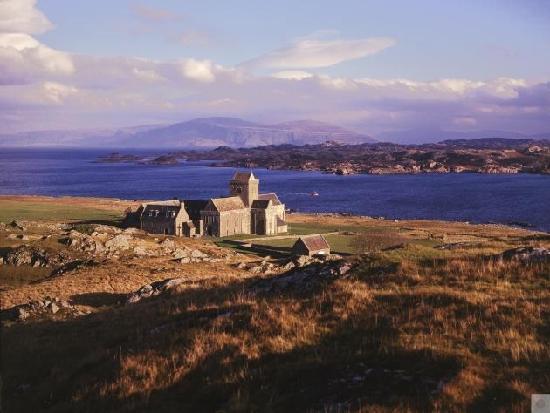
at Iona.
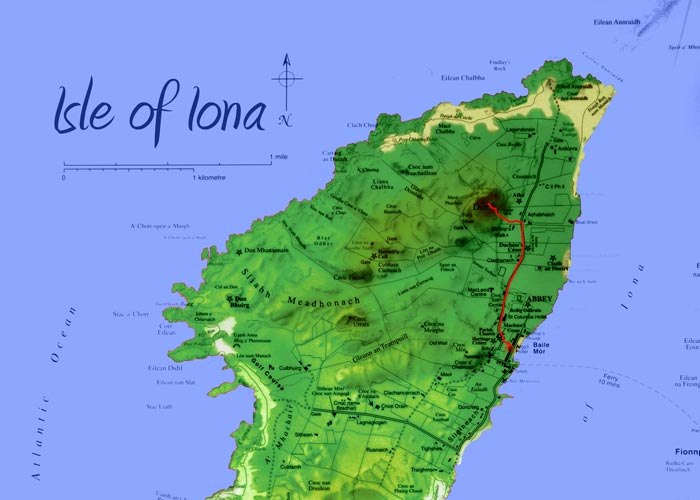
The text was based on an account of a pilgrimage to Nazareth made by the Frankish bishop Arculf, who talks about a church, ‘where once there was the house in which the Lord was nourished in his infancy.’
He writes: ‘The other stood nearby and was built near a vault that also contained a spring and the remains of two tombs.’
‘Between these two tombs was the house in which Jesus was raised. From this is derived the more recent name for the church that Adomnàn described’.
An ancient text written in 670 described the house as located between two tombs and below a church.
In the Byzantine era, and again in the 12th century at the time of the Crusades, the ruins of the building were incorporated into churches – suggesting it was of great significance and needed to be protected, the Reading University archaeologist argues.
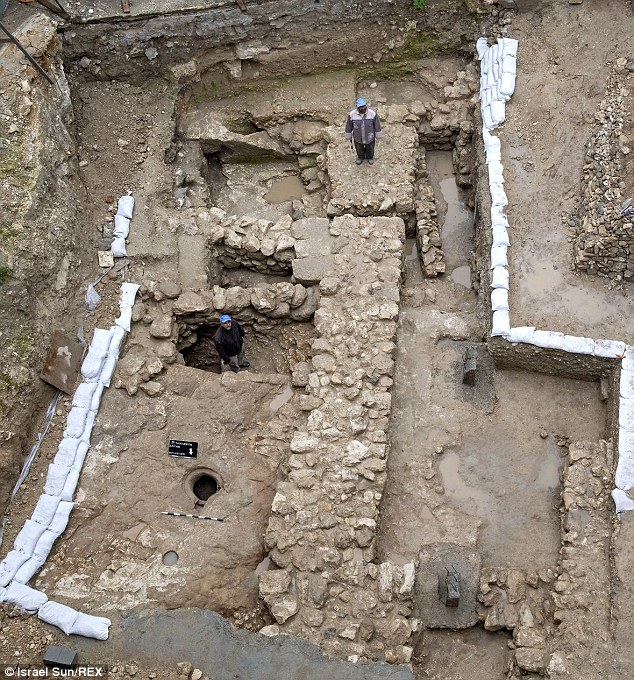
Some excavations in progress above.
The account of the Sisters of Nazareth Convent matches this, because there is evidence of a large Byzantine church with a spring and two tombs in its crypt, Dr Dark writes.
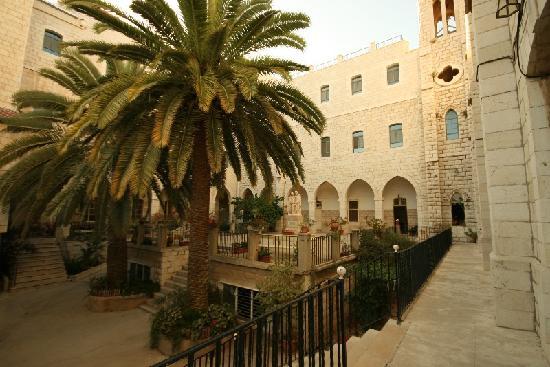
The house he believes was Jesus’ boyhood home stands in between the two tombs which also matches with Adomnàn’s account.

The base of the statue of the Holy Family, located in the center of the courtyard, bears the date of 1855 (MDCCCLV) when the construction was started.
Under the courtyard of the convent is a first-century tomb, once sealed by a rolling stone, and an earlier house dating from the same century.
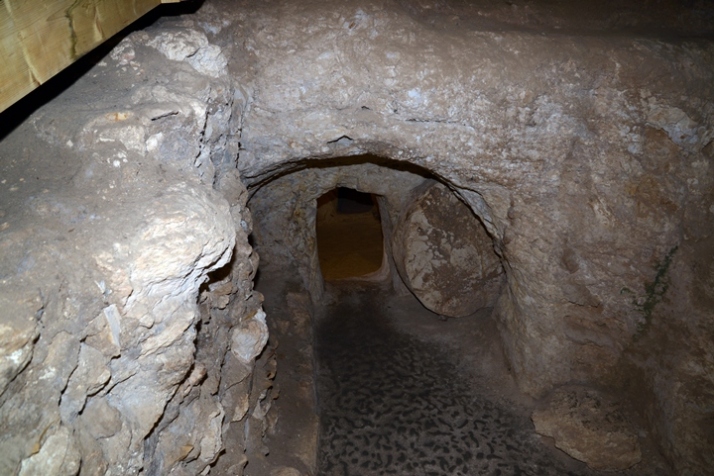 The deep courtyard in front of the entrance to this tomb is that which cut through the earlier house. On one side it is possible to see the rolling stone that once covered the entrance.
The deep courtyard in front of the entrance to this tomb is that which cut through the earlier house. On one side it is possible to see the rolling stone that once covered the entrance.
Under its courtyard are ancient remains dated to the Early Roman period.
Other Archaeological evidence was discovered under the convent, including a dwelling house, tombs, water cisterns and a church. These date from the 1st century AD and the Byzantine, Crusader and Ottoman periods.
The complex consists of a number of rock hewn cavities, cut for various functions over a period of 2,000 years, and built walls of various dates. The area is oriented south-north, where the north side against the hillside.

A freehand sketch of the underground complex is illustrated here, indicating the points of interest.
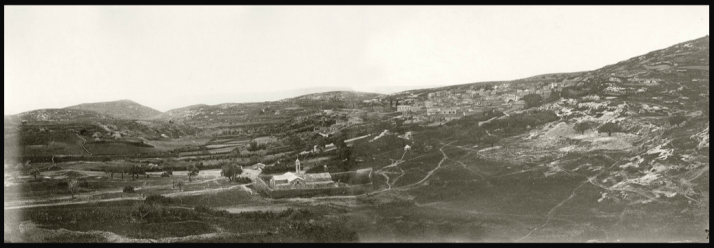 The location of the site, as indicated on the illustration, is on the slopes of the Nazareth hills.
The location of the site, as indicated on the illustration, is on the slopes of the Nazareth hills.
The modern Casa-Nova street follows the path of the wadi, passing on the west and north sides of the Annunciation Church.
The structures found under the convent were cut into the hillside, on the southern end of the limestone ridge, parallel and above the wadi. This dictated the plan of the Roman period house, the tombs and cisterns, and the constructions of the post-Roman period structures, and it also meant that the rock-cut walls survived better than the usual stone-built walls.
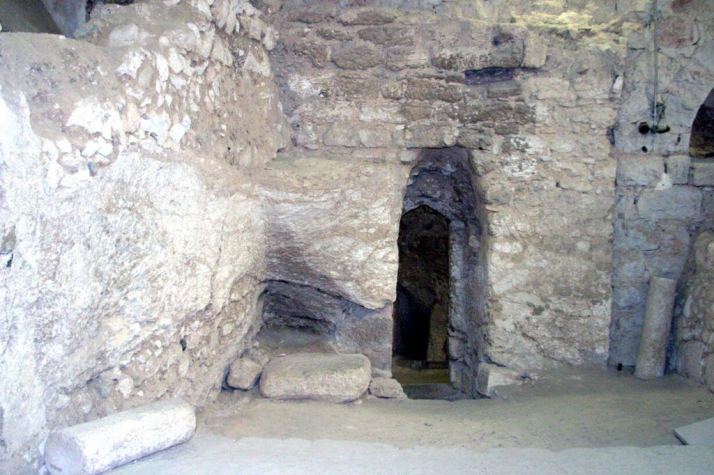
The house was also cut into a limestone hillside and has a series of rooms and a stairway. One of the original doorways has survived, as has part of the original chalk floor.
Writing in the journal Biblical Archaeological Review, Dr Dark says that while he has no proof, there is ‘no good reason’ to believe it was not Jesus’s home. He has been researching the ruins, in what is now northern Israel, since 2006.
Jesuit priest Henri Senes carried out more work in 1936.
Since 2006, Dr Dark’s team has discovered broken cooking pots, a spindle whorl and limestone artifacts.
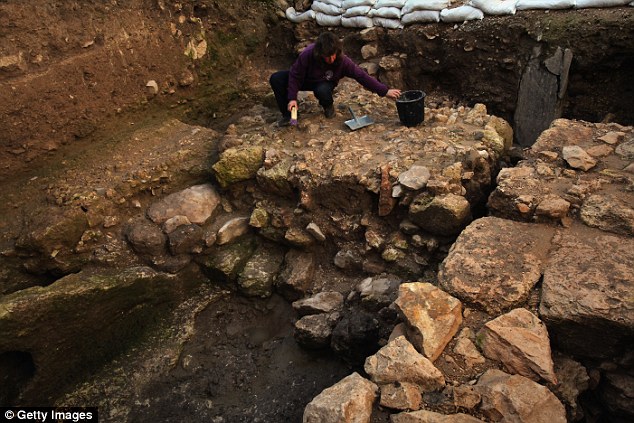
The limestone items suggest a Jewish family lived there as Jews believed that limestone could not be impure – and Mary and Joseph were living in Nazareth when the angel Gabriel revealed that Mary would give birth to the son of God, a baby to be named Jesus.
In the ancient text, it details a church “where once there was the house in which the Lord was nourished in his infancy”.
The entrance to the convent is through a beautiful gate, as seen in the photo below.
On top of the gate is a small statue of Saint Joseph holding infant Jesus.

The photo shows the east side of the monastery, on 6167 street of the Latin quarter of Nazareth.
The last attempt to identify the house where Jesus grew up was in 2009 when archaeologists from the Israel Antiquities Authority found another 1st century home they believed had been occupied by a Jewish family.
Dr Dark, a specialist in first century and Christian archaeology, argues that the house he believes was Jesus’s boyhood home matches Adomnan’s account.

The house is located near the Basilica of the Annunciation (pictured). Overall the design was typical of early Roman settlements in the Galilee.

In 2009 archaeologists from the Israel Antiquities Authority found another 1st century home nearby they believed had been occupied by a Jewish family. However they were able to say only that Jesus may have lived near the site.
Further digs were conducted by Jesuit priest Henri Senes in 1936.
Since beginning their research in 2006, Dark and his team have discovered various limestone artifacts on site, suggesting a Jewish family lived there, as Jewish people at the time believed limestone items to be pure, according to the report.
Although Dark is not able to say with absolute certainty that Jesus indeed grew up in the much examined home, he says “there is no good archaeological reason why such an identification should be discounted.”
Descent to the underground complex
A modern staircase leads down from the monastery to the underground complex.
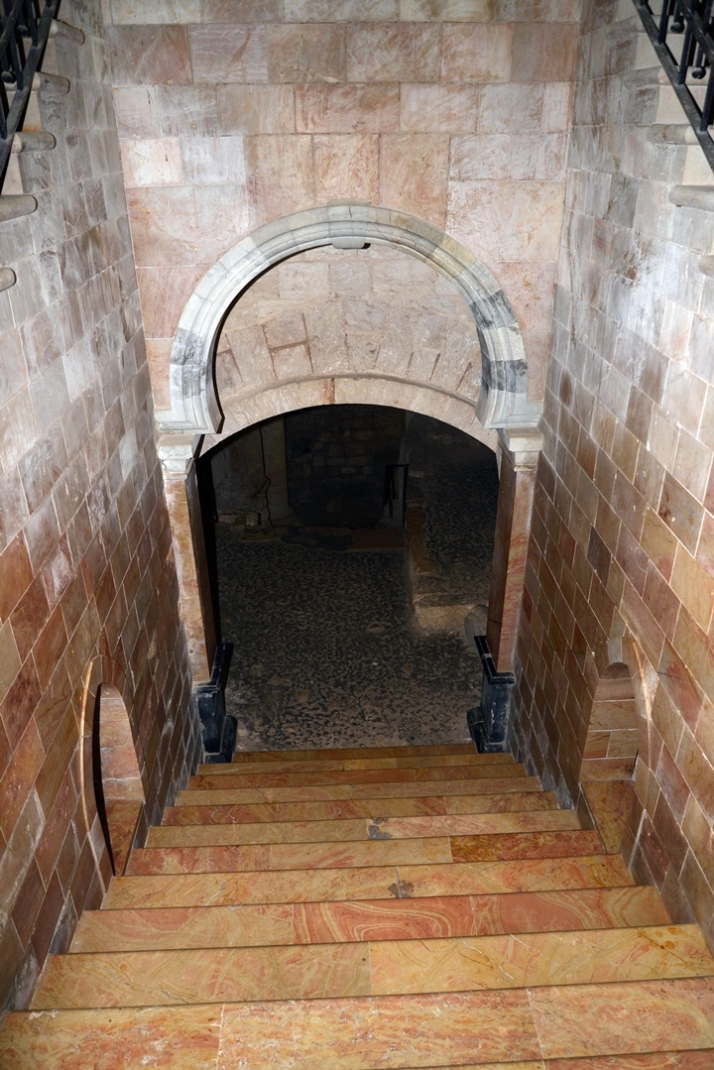
The staircase leads right to an underground rock hewn chapel, or cave-church. A pair of steps lead up to the cave, where an altar is located.
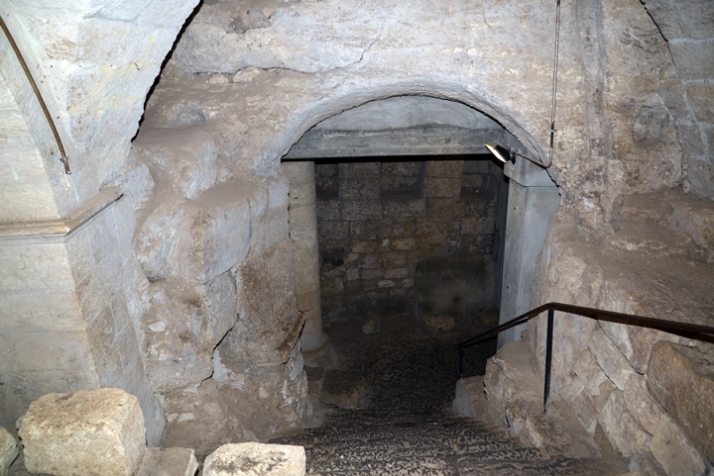
Chapel and cisterns
The staircase leads right to an underground rock hewn chapel. A pair of steps lead up to the cave, where an altar is located.
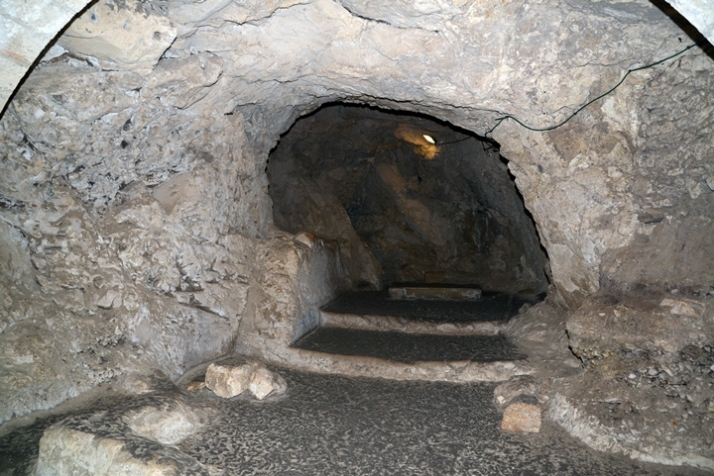
- The cave-church is located under an opening, seen in the photo below.
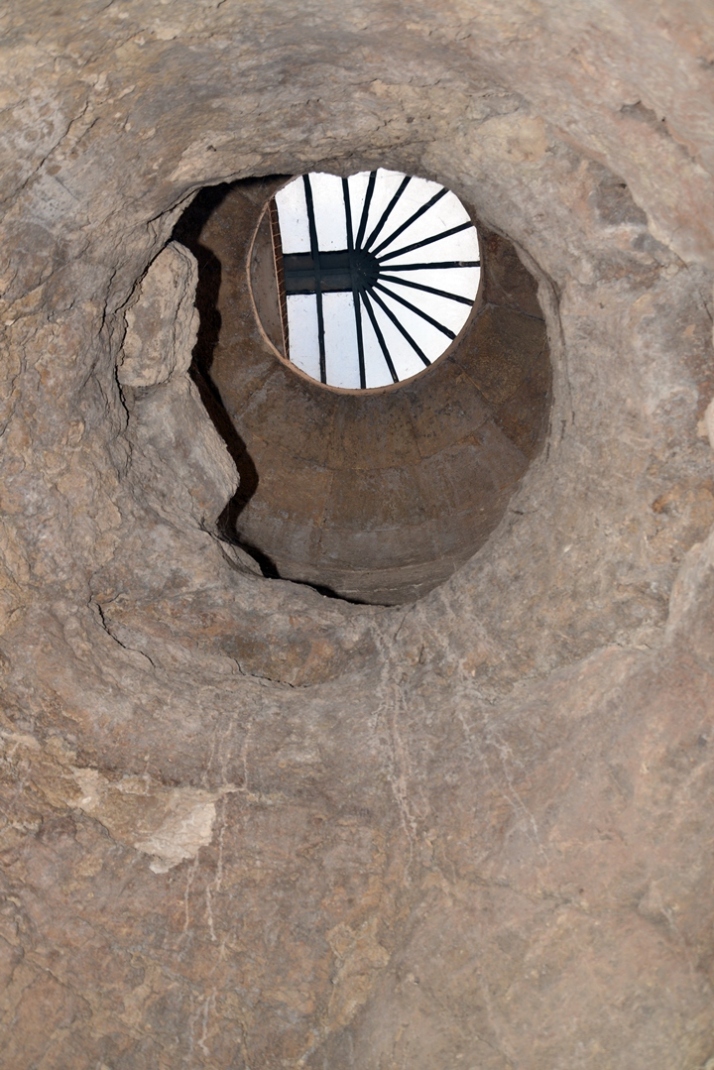
This opening is a light-well, a feature found in other Byzantine churches and designed to let natural light onto the altar, which presumably stood below it. Today the base of a modern altar stands in approximately the same position.
The cave-church was made in the Late Roman or Byzantine period by cutting back into the rock from one side of a Roman-period tomb, remains of which can be seen in the cave-church.

The location of the chapel is indicated on the map with a red square.
The following photo is a closer view of the cave-church.
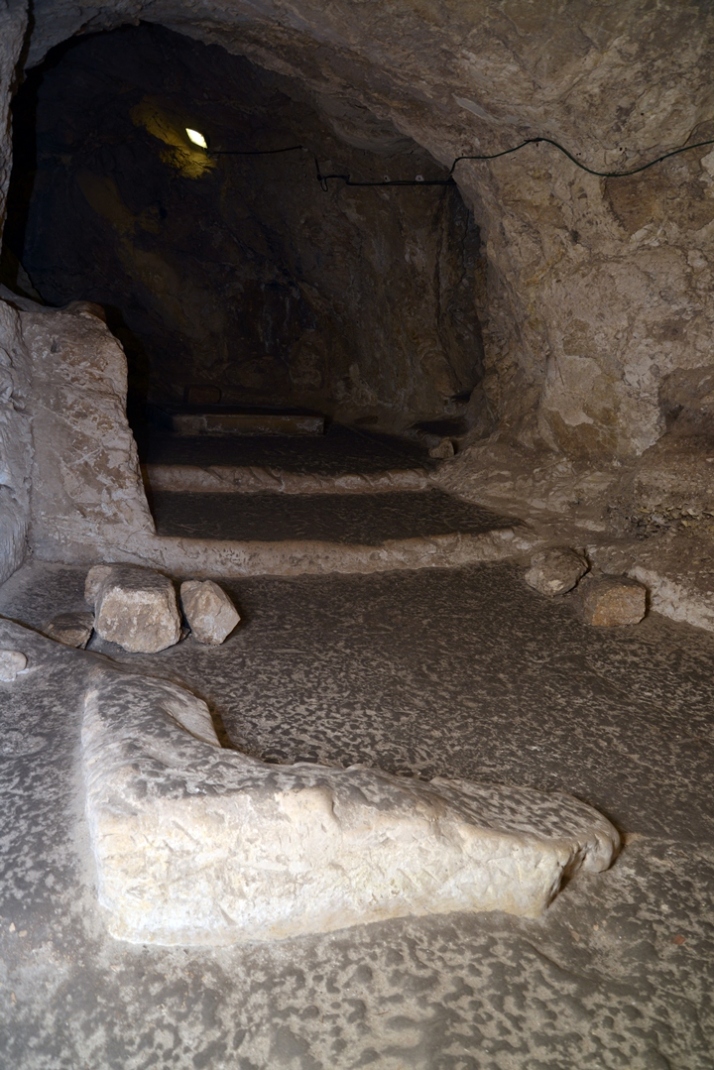
- When the cave was excavated in the nineteenth century, the nuns found a skeleton of a man in a crouched position to the left of the L-shaped stone on the bottom left side.
This burial was probably part of the tomb preceding the cave-church, but carefully preserved inside it when the cave was cut into the rock.
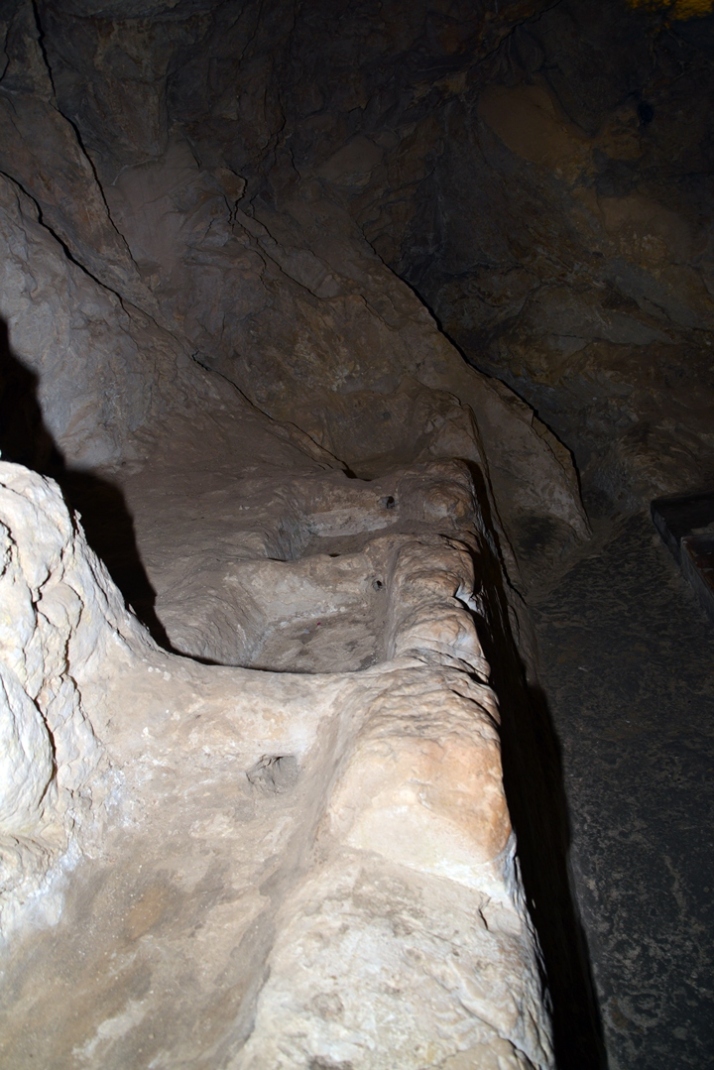
On the western wall of the chapel is a number of small basins, all connected to each other by a small hole.
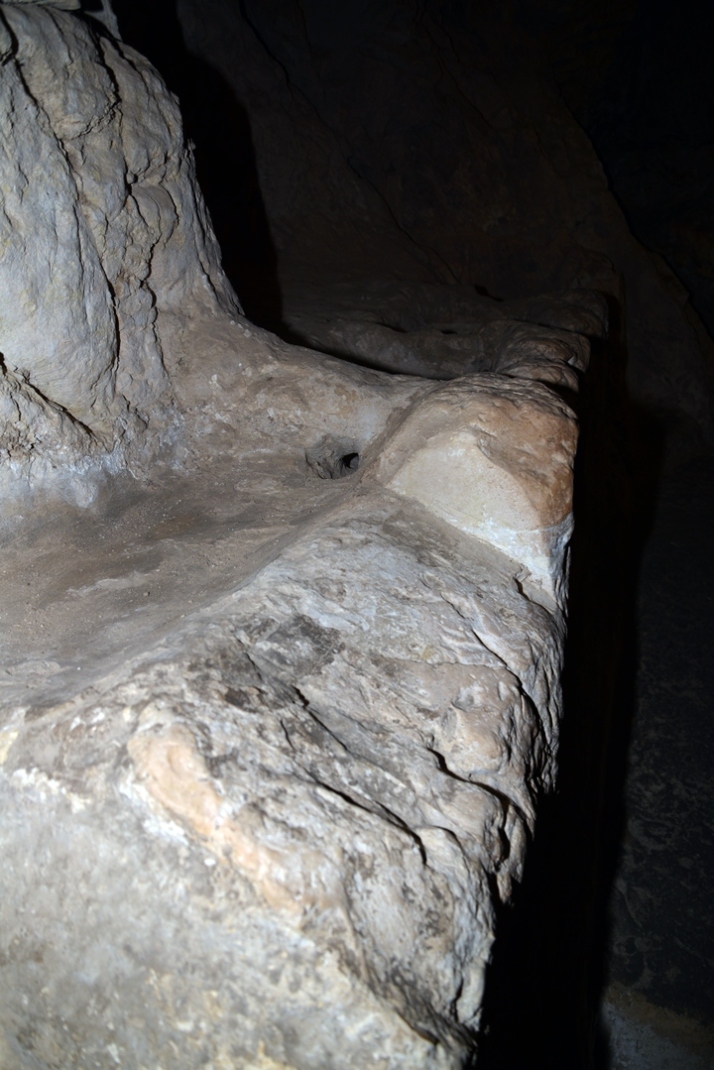
This might have been an agriculture installation, used by the monastery to produce wine. Guessing from the type of installation, it may be dated to the Byzantine period.
Burial Loculi (North)
Another trace of the earlier, Roman-period, tomb can be seen at the south end of the cave, where a pair of burial cavities (loculi) are hewn at the edge of a narrow passage on the south west side of the cave-church. One of these had a complete skeleton at the time of discovery. These were again carefully preserved when the cave-church was constructed, showing the respect its builders had for the earlier burials.
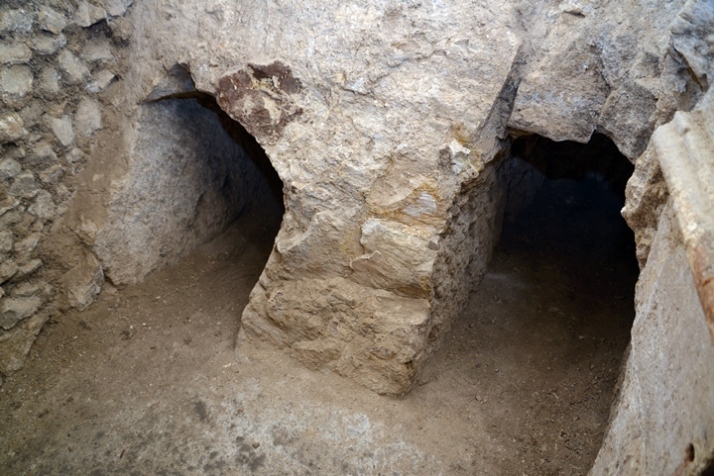
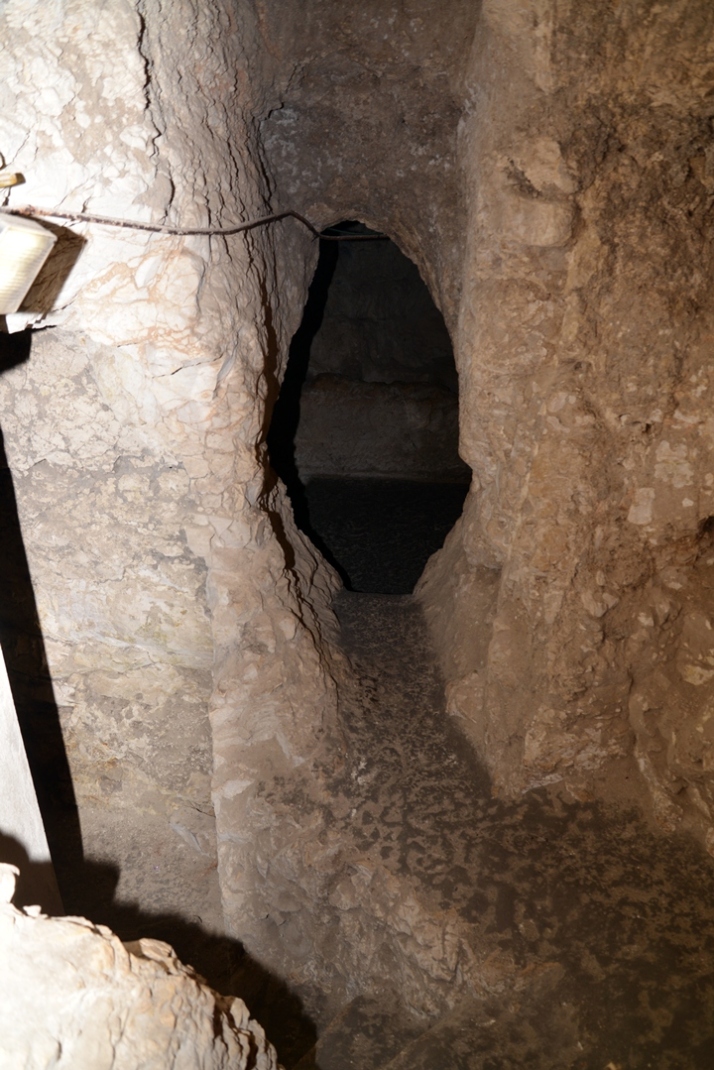
Another cavity is adjacent to these loculi. It opens to a passage to the western wall, where according to nineteenth-century reports there were additional rock hewn loculi.
Corridor
Turning left from the modern staircase, a corridor between the south and north sections passes along another set of niches in the wall, although these are of much later date, and then opens into a number of chambers.
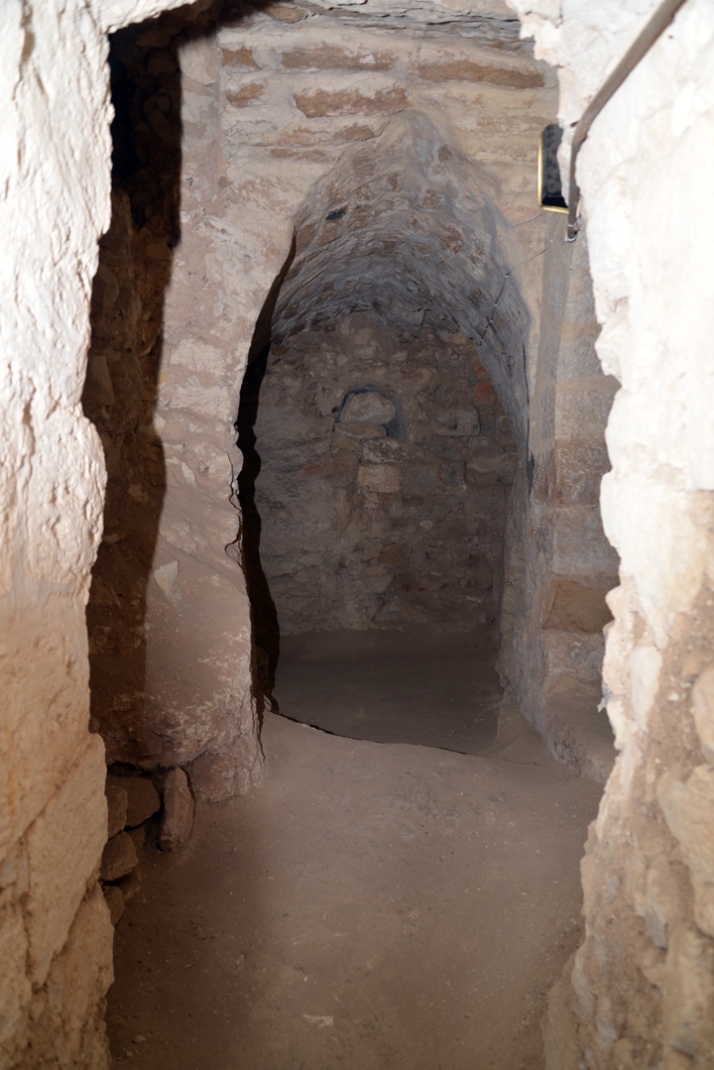
Crusaders period staircase

The location of the two staircases is indicated on the map with a red square.
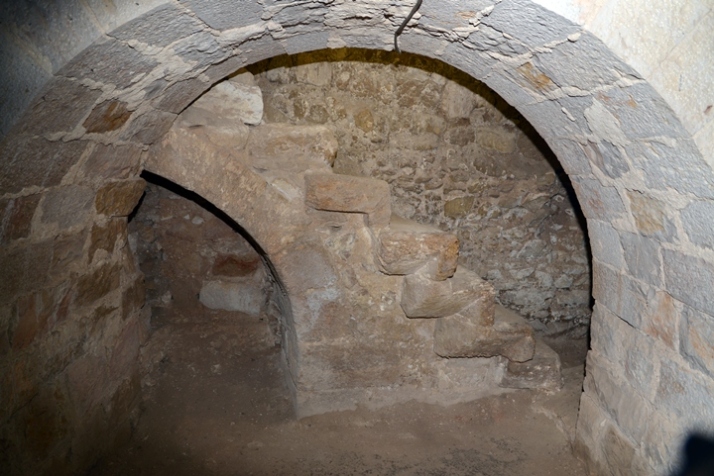
The photo above shows eastern staircase, located behind an arch. On the south side of the complex, adjacent to the dwelling house, is a pair of staircases. They are dated to the Crusader period.
The other staircase is seen here: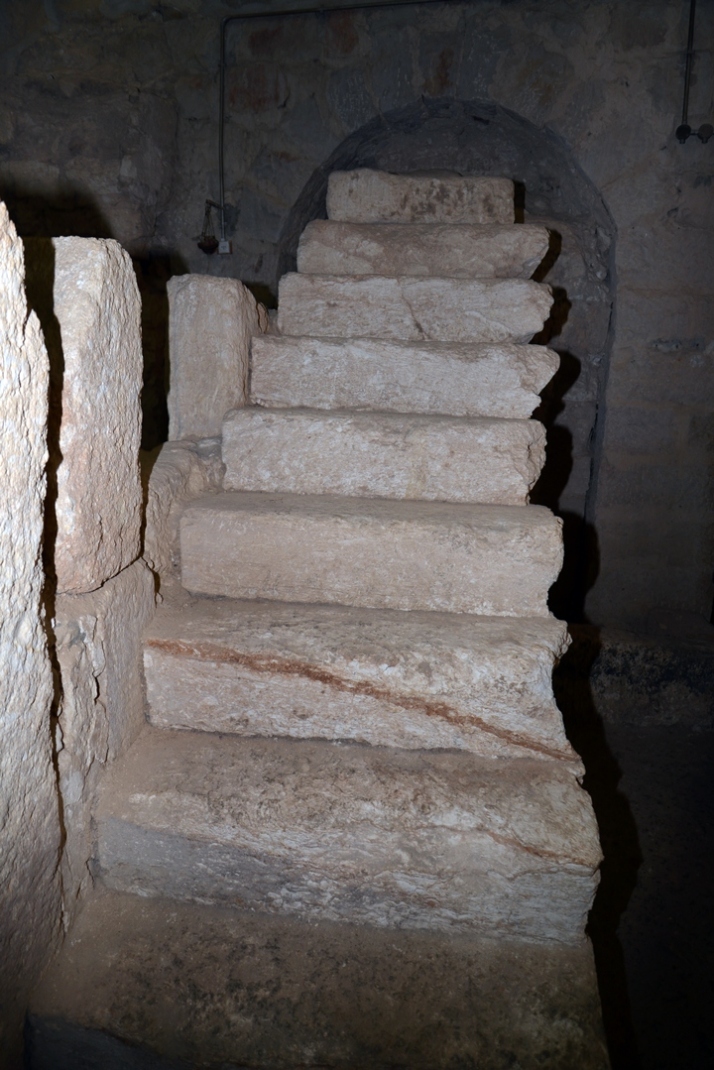
Another view of the western staircase is seen here. The wall and the staircase are from the Crusader-period. It is possible that, although certainly rebuilt in the Crusader period, this wall may have been based on an Early Roman period wall, belonging to the house on the west side.
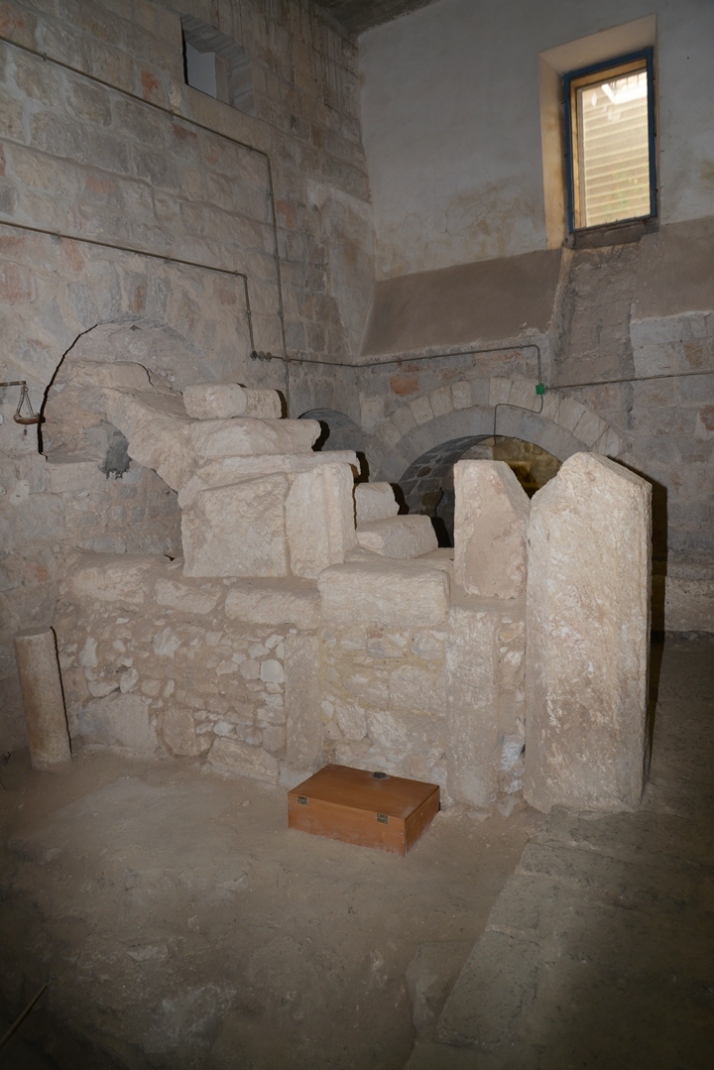
Another set of steps is located on the western side of the cellar.
Early Roman House
Ruins of a dwelling are located on the south side of the complex, The photo below shows its entrance and the wall on the left side partially cut into the hillside rock.

The location of the house is indicated on the map with a red square.
Part of the original floor of the house can be seen just inside the doorway. Professor Ken Dark interpreted this structure as an Early Roman period house, perhaps the type of “courtyard house” found at other sites. It can be dated to the 1st Century AD. The large area in front of the opening was the largest room, while the small opening was an entrance to the northern smaller room.
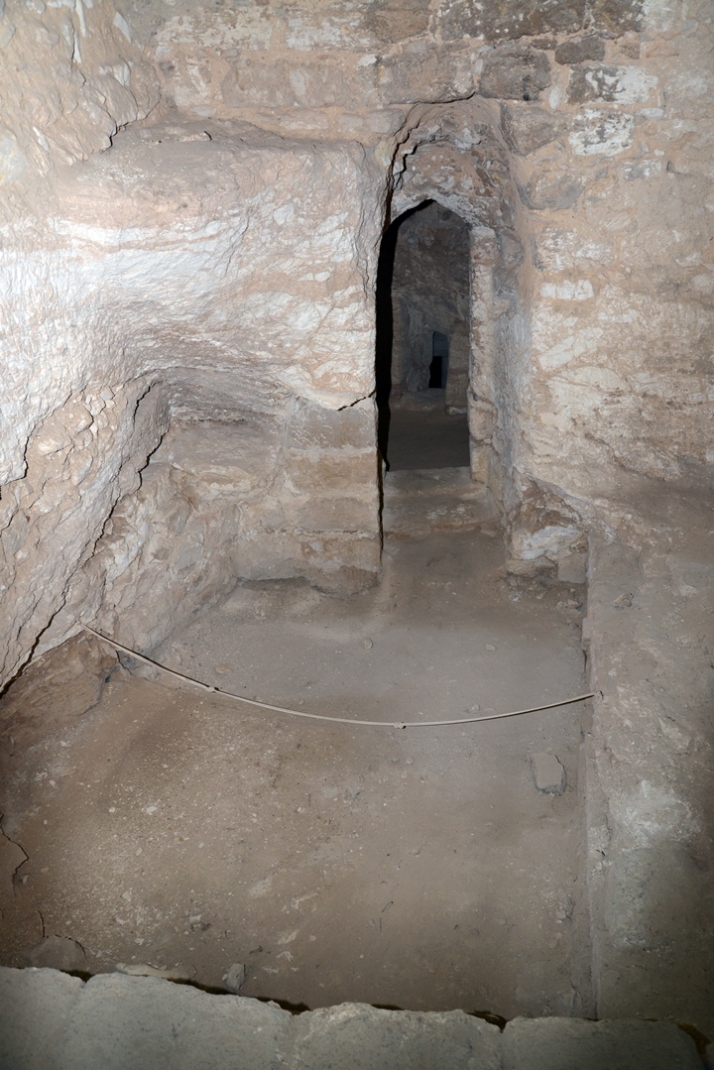
Professor Ken Dark was able to show that after the house was disused small-scale quarrying cut away part of its southern side. This quarrying was, in turn, cut into by the deep forecourt of another tomb, of a type dateable to the first century AD. So a sequence of house, then quarrying, then tomb could be seen, probably all before the end of the first century
Records made when the present convent was built show that a large Byzantine church, decorated with floor- and wall-mosaics, once stood above the visible remains. Ken Dark has argued that this surface-level church was the Byzantine ‘Church of the Nutrition’, described in the seventh-century pilgrim account De Locis Sanctis.
The Byzantine Church of the Nutrition was said to have had preserved in its crypt (cellar) the house where Jesus was brought up. Ken Dark has suggested that the 1st-century dwelling house visible today was the house that the Byzantines believed was the house where Jesus was brought up, but says that it is impossible to know today whether the Byzantines were correct in believing that.
The location of the house, only 100m from the Annunciation Church, combined with its Second Temple period date, makes this a serious possibility, but, as he says, it is impossible for archaeology to prove.
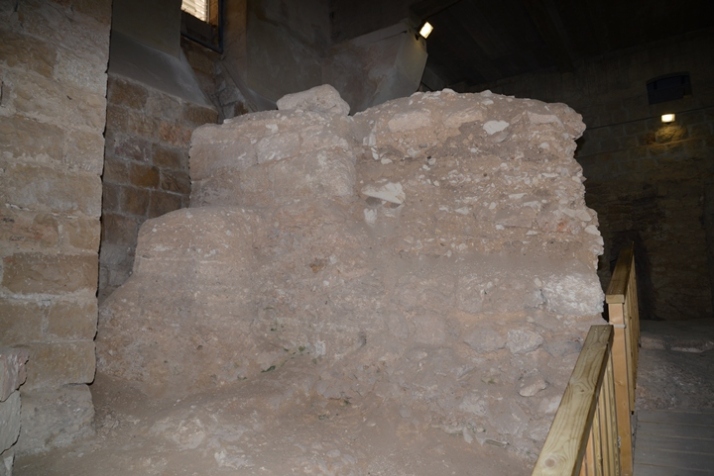
On both sides of the house are sections of Crusader -period wall. There is also a small section of the western wall of the Early Roman period house, seen here on the bottom left side.
Surviving fragments of rock-cut wall show that the house originally extended to the west, east and south, but it is impossible at this time to determine its exact dimensions and total plan as only part of it is within the present cellar.
The surviving part of the larger room was rectilinear about 10m long by 4-5m wide, with the smaller concealed room 2m long by 4-5m, built against the slope of the hill which rises to the north. According to the “Courtyard” house model, the main family room would have been beyond the western wall, while a courtyard with a cistern would have been located to the south.
Further excavations at the site are unlikely to take place, but even on the basis of what is already known this may well be one of the most important archaeological sites in Nazareth.
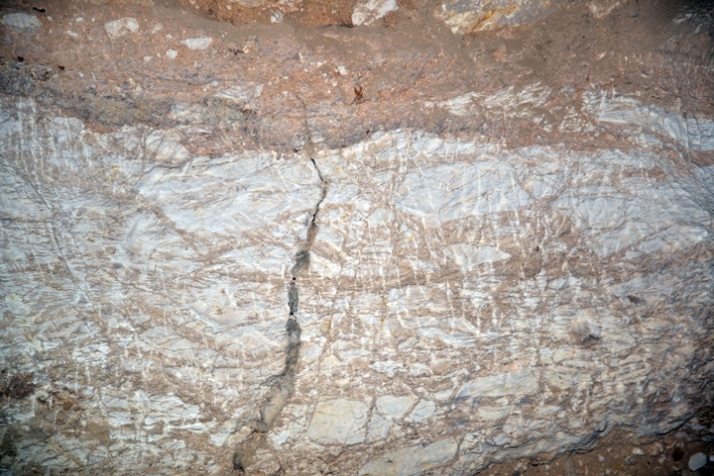
- On the rock to the side of the house is a small engraving. It is not clear what this means, nor what date it is. Sister Stefania also pointed out another engraved sign on the rock, which looks like a fish.
Crusaders platform
A rectilinear paved platform is located in the front of the house, dated to the Crusaders period. An east-west wall, seen on the left side, is also dated to the Crusader period.

A rectilinear paved platform is located in the front of the house, dated to the Crusaders period. An east-west wall, seen on the left side, is also dated to the Crusader period.
On the corner of the paved platform is a covered opening to a vertical shaft. Ken Dark suggests that this is a Crusader-period ‘squint’, a feature found in medieval Western European churches, placed to allow medieval pilgrims to view the altar beneath, inside a small chapel located on the side of the tomb below.
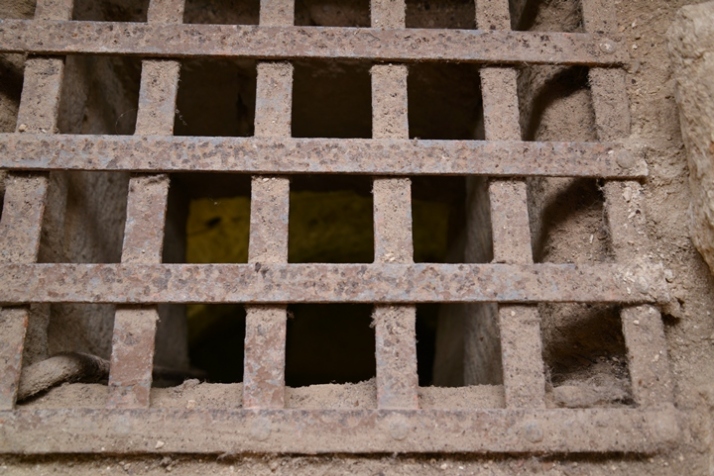
Burial Loculi (South)
An Early Roman-period tomb (mentioned above) is cut into the rock-face immediately south of the house.
This is well-preserved and again contains loculi (burial cavities).

The location of the tombs are indicated on the map with a red square.
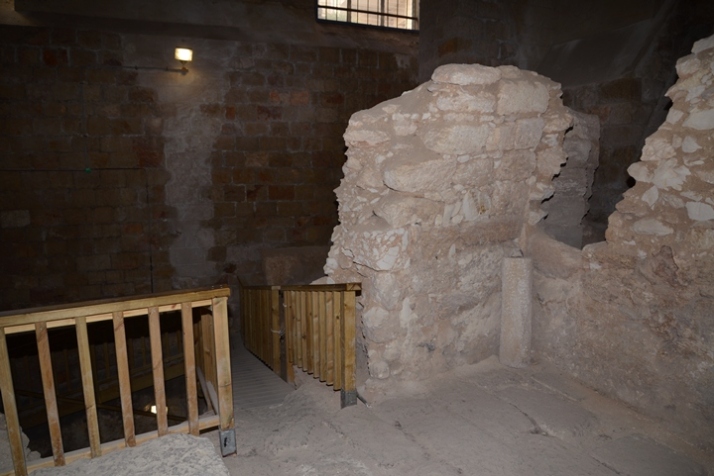
A modern wooden bridge leads down to the level of the tombs.
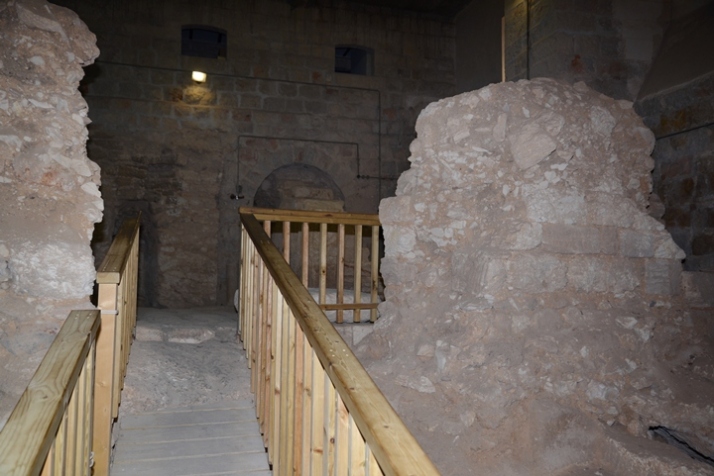
A reverse view from the bridge towards the platform level of the house is seen in the photo:
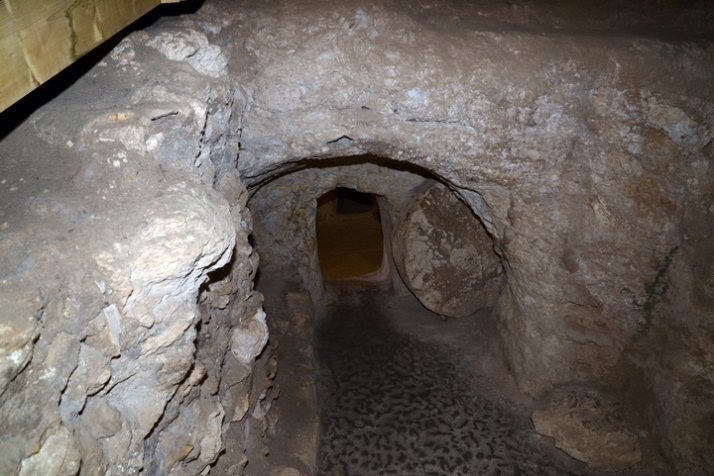
On the level under the residential house is an opening to a family burial cave. A rolling stone seals the entrance.
The deep courtyard in front of the entrance to this tomb is that which cut through the earlier house. On one side it is possible to see the rolling stone that once sealed the entrance to the tomb itself.
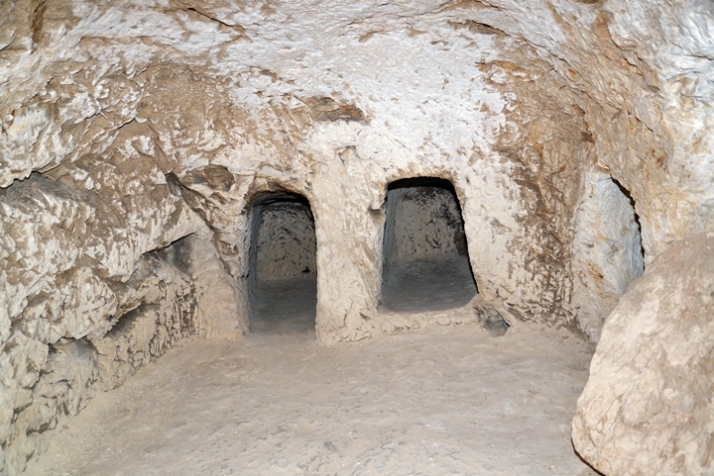
A number of burial cavities are cut inside the tomb. This burial type was a Jewish tradition during the Roman and Byzantine period, and thousands of rock hewn burial loculi exist in the Holy Land. This practice is based on the sacred Jewish religious duty of proper burial, as attested in numerous cases in Scripture.
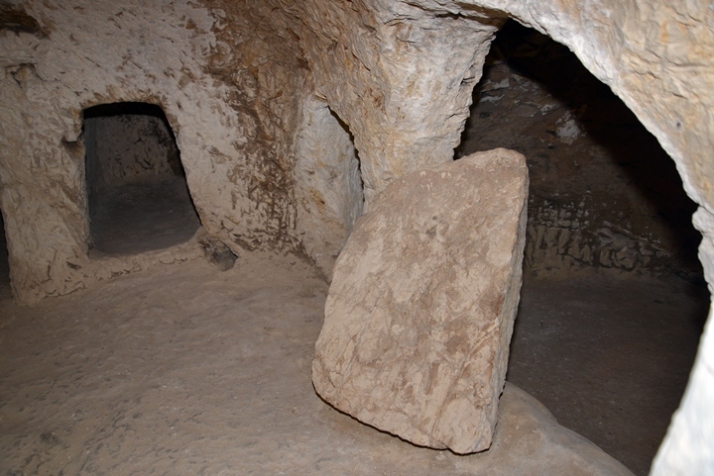
Note that it is unusual to find tombs near a residential house, as cemeteries were always located outside of the Jewish residential areas. However, in this case the tomb cuts through quarrying, which cut through the disused house. So the house was out of use before the tomb was constructed.
Rolling stone
A rolling stone (Hebrew: Golel) is located at the entrance to the tomb. It is 33 cm thick and 109 cm in diameter, and slides in a rock cut groove. This heavy stone was used to seal the entrance after the burial of a family member, in order to stop animals and grave-robbers entering, and also to prevent the “impurity” (Tum’ah) escaping.
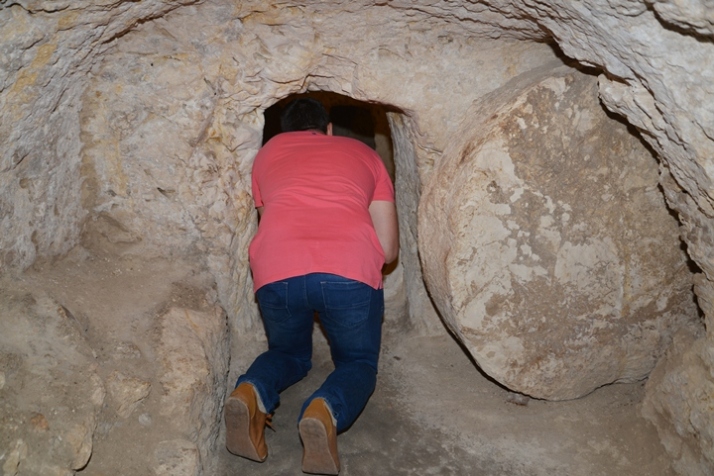
The use of rolling stones started in the Second Temple period, and then became very common throughout the Roman and Byzantine periods, but the design of these tombs changed in that time. For example, tombs dated to the first Century AD, as at the Sisters of Nazareth, have larger rolling stones than those dated later.
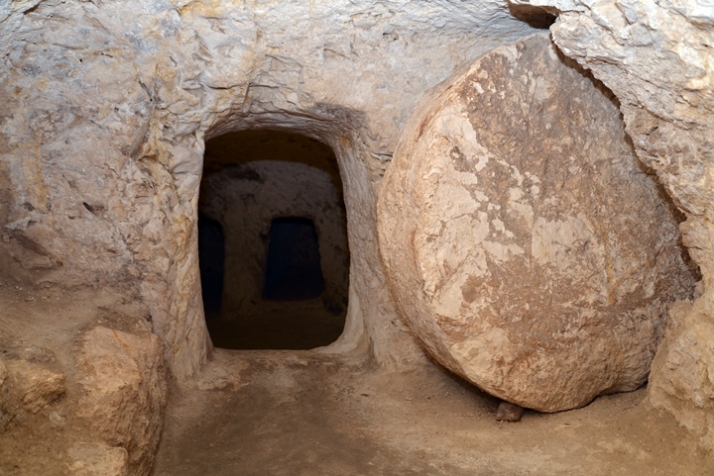
During the first temple period, tombs were sealed with square blocks. The use of rolling stones started in the second temple period, and then became very common throughout the Roman and Byzantine periods.
This fact was used by critiques of the earlier dating time of the tomb, as they claimed that rolling stones were used only during the middle of the 1st Century AD, suggesting that the tombs are dated later than 100 AD. Future excavations could shed more light on the dating issue.
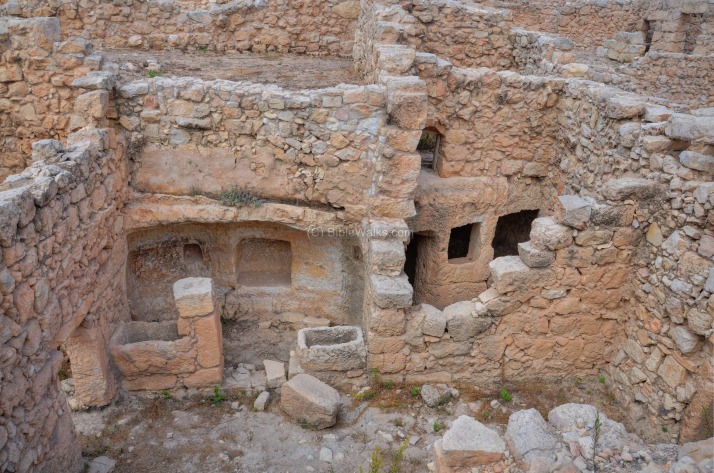
Summary: What do we know about ‘Jesus home’?
Clues found in ‘De Locus Sanctis’ written in 670 AD by abbot Adomnàn
-
It was supposedly based on a pilgrimage made to Nazareth by a bishop
-
Text says how Jesus’ home was between two tombs and below church
-
Dr Ken Dark says house located beneath Sisters of Nazareth Convent
-
There is evidence of a Byzantine church here with two tombs in its crypt
-
One of the doorways has survived, as has part of the original chalk floor
Artifacts at the site included broken cooking pots, a spindle whorl and limestone artifacts.
The limestone items suggest a Jewish family lived there as Jews believed that limestone could not be impure.
The house has been cut out of a limestone hillside and having a series of rooms and a stairway. One of the original doorways has survived as has part of the original chalk floor.
The house is located beneath the Sisters of Nazareth Convent which is across the road from Church of Annunciation in Nazareth.
Subsequent generations after the first century took great care to look after the site. The house was decorated with mosaics in the Byzantine period, suggesting that they were of special importance.
So there is a distinct possibility that this may have been where He lived….
~
Jesus’ Burial Slab:
Perhaps the most important finding in the history of Christianity was made in just the last few months when archaeologists excavating the alleged Tomb of Christ found the burial slab which Jesus was laid to rest on.

Jesus’s burial slab was found this year.
Restoration workers who were plying their trade on the Church of the Holy Sepulchre in Jerusalem stumbled upon the rock surface which Jesus was apparently rested upon.
The slab has not been seen since 1555 when it was enclosed in the Church of the Holy Sepulchre which contains the Tomb of Christ.
Christians claim following his crucifixion, Jesus was laid on the slab, or “burial bed” and enclosed in a tomb before being resurrected and ascending to Heaven several days later.
Centuries later, followers of Christ took the slab to what is now the Church of the Holy Sepulchre, where it has remained hidden for almost 500 years.
National Geographic’s resident archaeologist, Fredrik Hiebert, said: “The marble covering of the tomb has been pulled back, and we were surprised by the amount of fill material beneath it.
“It will be a long scientific analysis, but we will finally be able to see the original rock surface on which, according to tradition, the body of Christ was laid.”
~
Mary’s Well
Below is a place called Mary’s well and gives a view of what the village would have looked like.
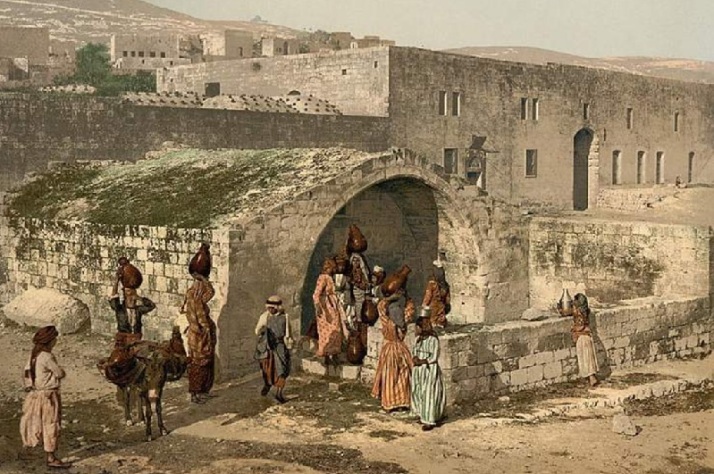
Along with the home, a number of water sources have also been found at Nazareth. They would have been accessed with Jesus was alive. This image shows a famous source known today as ‘Mary’s Spring’
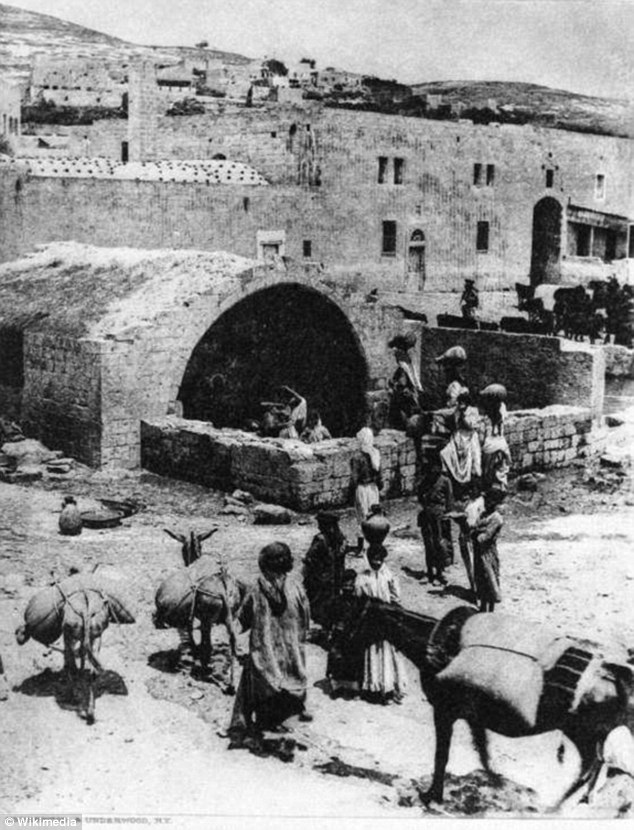
Nazareth today and we do know that Jesus does not live here anymore.
But… He is alive and living with the Father in His Glory, waiting for the Father to tell Him to go and get His Bride. Meanwhile, He is also living in our hearts through the presence of His Holy Spirit, for the Kingdom of the Heavens is within us.
So yes, Jesus does live ‘HERE’, wherever we are!

